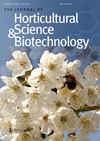CHESTNUT (CASTANEA SATIVA MILL.) GENOTYPE IDENTIFICATION: AN ARTIFICIAL NEURAL NETWORK APPROACH
IF 2.1
4区 农林科学
Q2 HORTICULTURE
Journal of Horticultural Science & Biotechnology
Pub Date : 1999-01-01
DOI:10.1080/14620316.1999.11511188
引用次数: 17
Abstract
SummaryThe potential use of the artificial neural networks (ANNs) for characterization and identification of seventeen chestnut (Castanea sativa Mill.) accessions, belonging to the ``marrone''-type and ``chestnut''-type, was investigated in genotypes originating from regions of Italy. Different back-propagation neural networks (BPNN) were built on the basis of image analysis parameters of the leaves, for two tasks of chestnut classification. In the first case a BPNN was built and trained to differentiate the 17 accessions of chestnut. In the second case a BPNN was conceived to distinguish between the ``marrone'' and ``chestnut'' types. BPNN produced a clear identification of all the accessions except in the case of `Garrone nero', `Garrone rosso' and `Tempuriva', which showed almost the same output diagram. Cluster analysis separated the 17 chestnut genotypes into four main groups whose differences were related to the original sources of the genotypes and to the type of affiliation (``marrone''-type or ``...板栗(castanea sativa mill)基因型鉴定:人工神经网络方法
摘要利用人工神经网络(ann)对意大利产栗子(Castanea sativa Mill.)的“marrone”型和“chestnut”型17份材料进行了鉴定和鉴定。基于叶片图像分析参数,构建了不同的反向传播神经网络(BPNN),分别用于板栗分类的两个任务。在第一个案例中,建立并训练了一个bp神经网络来区分17种栗子。在第二种情况下,BPNN被设想用来区分“栗子”和“栗子”类型。除了“Garrone nero”、“Garrone rosso”和“Tempuriva”外,BPNN对所有的加入都产生了清晰的识别,它们显示了几乎相同的输出图。聚类分析将17个栗子基因型划分为4个主要群体,其差异与基因型的原始来源和亲缘关系类型(“marrone”型或“marrone”型)有关。
本文章由计算机程序翻译,如有差异,请以英文原文为准。
求助全文
约1分钟内获得全文
求助全文
来源期刊
CiteScore
3.90
自引率
5.30%
发文量
67
审稿时长
3 months
期刊介绍:
The Journal of Horticultural Science and Biotechnology is an international, peer-reviewed journal, which publishes original research contributions into the production, improvement and utilisation of horticultural crops. It aims to provide scientific knowledge of interest to those engaged in scientific research and the practice of horticulture. The scope of the journal includes studies on fruit and other perennial crops, vegetables and ornamentals grown in temperate or tropical regions and their use in commercial, amenity or urban horticulture. Papers, including reviews, that give new insights into plant and crop growth, yield, quality and response to the environment, are welcome, including those arising from technological innovation and developments in crop genome sequencing and other biotechnological advances.

 求助内容:
求助内容: 应助结果提醒方式:
应助结果提醒方式:


